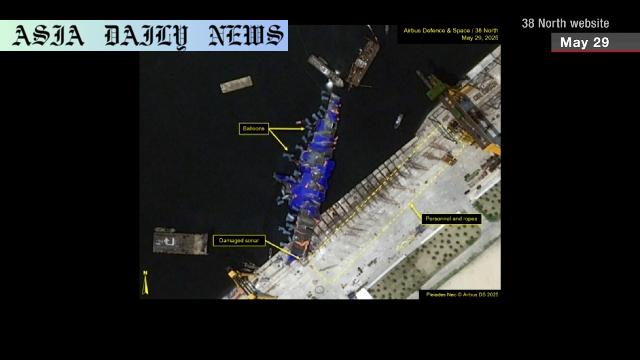Destroyer restored upright amid damage concerns at Chongjin Shipyard.
- The capsized North Korean destroyer is now upright, analysts report.
- Efforts involved manual rope operations with personnel and balloons.
- Chongjin Shipyard lacks adequate repair facilities, analysis shows.
- Kim Jong Un ordered restoration ahead of a June party meeting.

Overview of the North Korean Destroyer Incident
In a surprising development, a US-based research organization, 38 North, has revealed that a North Korean destroyer that capsized during its launch ceremony in May 2023 has now been restored to an upright position. The vessel, marred by a dramatic accident on May 21, had been lying on its side and partially submerged at the Chongjin Shipyard in the northeast of the country. Satellite imagery analyzed by 38 North confirmed the vessel’s altered positioning, indicating a determined effort to recover the warship from its precarious situation.
Crisis at Chongjin Shipyard
The Chongjin Shipyard faced a major setback last month when the destroyer’s capsizing disrupted operations and dented its reputation. Repair solutions for the damages appear limited, given the inadequacy of the shipyard’s repair equipment and facilities. According to the analysis, the sonar bow position of the vessel sustained visible damage during the accident, further complicating restoration prospects. Strikingly, the analysis suggests that North Korean personnel manually used ropes and balloons to painstakingly lift and restore the destroyer to its upright state. This herculean effort demonstrates North Korea’s resolve in managing the situation amid seemingly insurmountable odds.
Political Implications of the Incident
North Korean leader Kim Jong Un reportedly issued direct orders to expedite the recovery and restoration of the destroyer before a scheduled Central Committee plenary meeting later this June. Observers suggest that Kim’s involvement highlights the symbolic importance of the vessel in military and political narratives within North Korea. As the country deals with the aftermath of this accident, the timeline raises questions about whether repair attempts are driven by technical needs or political pressures.
A Closer Look at Restoration Efforts
The satellite images taken last Thursday provided a detailed snapshot of the ongoing restoration efforts. Personnel could be seen manually working on the vessel, relying on traditional tools and techniques rather than advanced technology, which the shipyard currently lacks. The presence of balloons for lifting highlights a resourceful, if rudimentary, approach to addressing the severe situation. This choice raises concerns about the durability of the recovery measures and whether further complications may arise during future vessel operations.
Broader Strategic Impacts
This incident and its aftermath point to larger implications for North Korea’s naval capabilities and aspirations. The destroyer could potentially represent a significant asset in the nation’s maritime strategy, and losing or severely compromising its functionality would be a blow to its ambitions. If successful, however, restoring the destroyer to operational status may bolster morale within the military and portray an image of resilience to international observers. This event also underscores the challenges faced by North Korean infrastructure and highlights recurring issues such as limited access to cutting-edge technologies necessary for effective naval development.
Future Outlook
As repairs proceed, questions loom about the sustainability of the restored vessel and whether it will meet full operational capacity before the June plenary deadline. While the determination shown by the workforce is impressive, relying solely on rudimentary techniques and equipment suggests that the shipyard is not adequately equipped for such critical tasks. Future progress will undoubtedly depend on how well North Korean engineers address the extensive damages and resource limitations. Furthermore, this incident may drive internal discussions regarding the need for more advanced shipyard technologies and infrastructure investments.



Commentary
Understanding the Significance of the Incident
The capsizing of North Korea’s destroyer and the subsequent efforts to restore it upright is an incident that showcases both the vulnerabilities and resilience of their military operations. While the accident itself raises questions about the technical standards maintained during launch procedures, the prompt restoration effort underlines the country’s tenacity despite substantial infrastructure limitations.
Manual Recovery Process Reflects Persistent Challenges
It is intriguing to note the reliance on manual methods, such as rope pulling and balloons, to restore the vessel. This reinforces the widely-held perspective that North Korea operates under significant resource constraints. However, the persistence and ingenuity displayed in recovering the capsized destroyer are commendable and illustrate the lengths to which nations will go to safeguard military assets. Such efforts also serve as a morale boost to those involved directly or indirectly in the recovery process.
Political Motivations and International Perceptions
The marked involvement of Kim Jong Un in fast-tracking the restoration further amplifies the political undertones of this event. North Korea undoubtedly views its military prowess as a critical pillar of state identity and ideological pride. Successfully reviving the destroyer ahead of the Central Committee plenary could carry symbolic weight, projecting an image of determination and resilience to both domestic and international audiences. However, this drive for symbolism might risk technical lapses or rushed work that could compromise the vessel’s long-term functionality.
The Road Ahead: Overcoming Challenges
As North Korea endeavors to rebuild its naval asset, the spotlight on this incident raises broader questions about the state of its shipyards and repair capabilities. Enhanced maritime capabilities are likely critical to its broader military goals, but this incident reveals deep-seated issues that could hamper progress. Perhaps this accident will inspire renewed focus on investing in infrastructure and technological tools to safeguard against similar occurrences in the future. Above all, the destroyer’s recovery underscores the challenges faced on the global stage, especially by under-equipped nations navigating complex technical and political terrains.